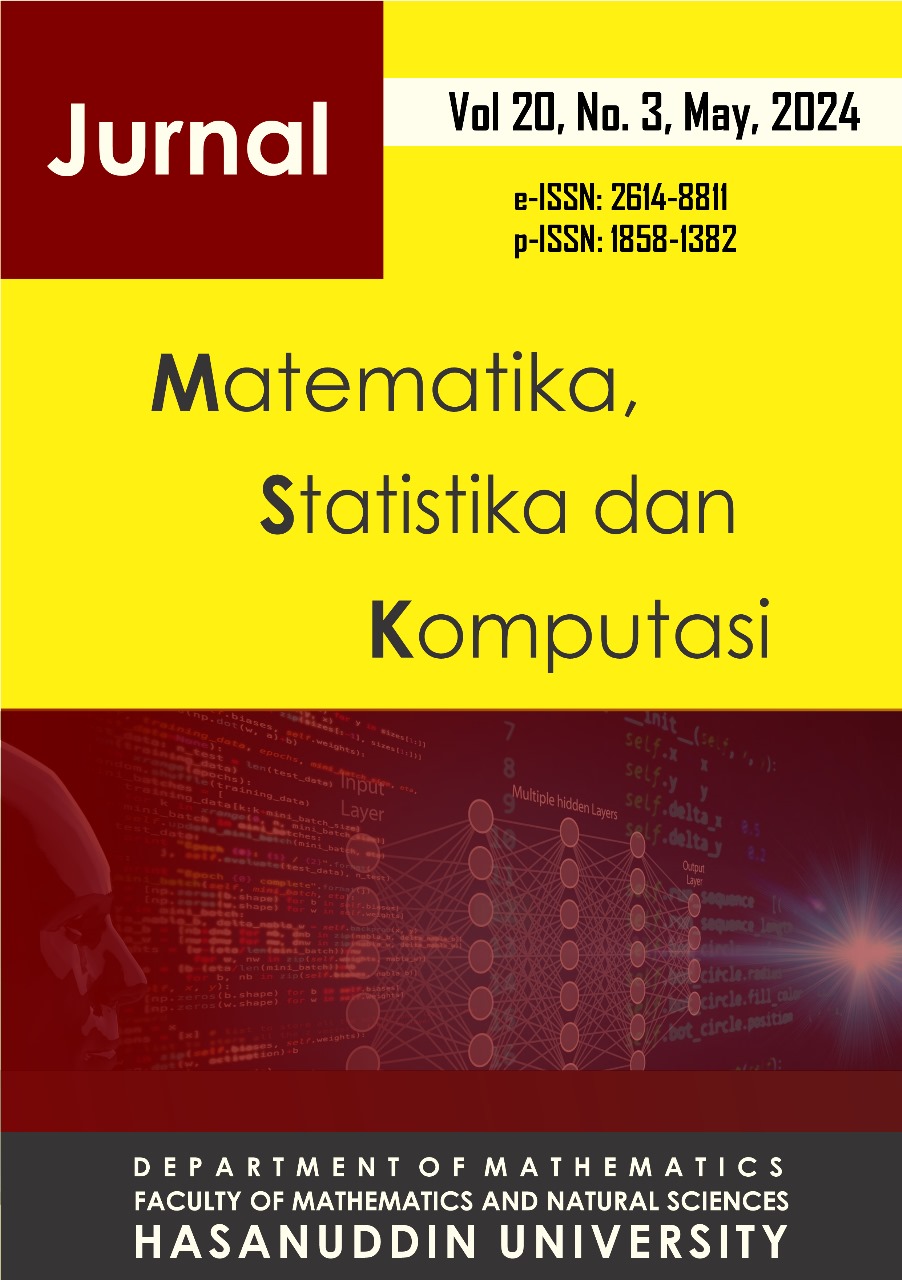Utilizing K-Means Clustering for Constructing Black-Litterman Portfolio Models
DOI:
https://doi.org/10.20956/j.v20i3.34165Keywords:
K-Means, Black-Litterman, Portfolio, InvestmentAbstract
A portfolio in finance is a collection of investment assets that aims to reduce risk by spreading investment across various assets. In building a portfolio, cluster analysis is used to select assets. K-Means cluster is often used because it is considered efficient for handling large data. In addition, the Black-Litterman Model is used because it can combine investor knowledge into asset allocation efficiently, so that the portfolio becomes more diverse, stable and adaptive to economic conditions, and reflects the investment manager's views. The research results show that k-means cluster analysis can be applied in forming the Black-Litterman model portfolio. Two clusters were obtained, namely cluster I consisting of ADRO, AKRA, BRMS, MIKA, TLKM, UNVR shares, and cluster II consisting of INDF, INKP, SMGR, UNTR. The two clusters were then formed into portfolios I and II. The calculation of expected return and portfolio risk shows that portfolio II produces profits (expected return portfolio) that are greater than portfolio I, namely 0.04445 or IDR 4.445.344,00, and the risk level of portfolio II is also smaller than portfolio I, namely 0.02104 or IDR 2.104.400,00Downloads
References
. Amanah, F., 2016. Analisis Tracking Error Untuk Mengukur Kinerja Portofolio Model Black-Litterman. Jurnal Matematika, Vol. 5, No. 5.
. Amanah, F., 2017. Pengukuran Kinerja Portfolio Black-Litterman Menggunakan Metode Sharpe Ratio. Seminar Matematika dan Pendidikan Matematika UNY 2017.
. Baiti, P.I.C. & Prasetya J., 2022. Analisis Non-Hierarchical Clustering dan Lagrangean Multiplier dalam Penentuan Bobot Portofolio Optimal Saham Perbankan Indonesia. JSA [Internet]. 2022 Dec.31 [cited 2023Oct.18];6(2):355 -365. Available from: https://journal.unj.ac.id/unj/index.php/statistika/article/view/29815 [31 Desember 2022]
. Das, D., Kayal, P., & Maiti, M., 2023. A K-Means Clustering Model for Analyzing The Bitcoin Extreme Value Returns. Decision Analytics Journal, 6, 100152.
. Gudono, 2012. Analisis Data Multivariat. Yogyakarta: BPFE.
. Haqiqi K.F. & Tohid, K., 2012. Int. Conf. Econ. Bus. Mark. Manag. 29 292.
. He, G. & Litterman, R., 1999. The Intuition Behind Black-Litterman Model Portfolios. Investment Management Division.
. Idzorek, T., 2004. A Step by Step Guide to The Black-Litterman Model : Incorporating user-specified confidence levels. Journal of Elsevier Finance.
. Jogiyanto, 2010. Teori Portofolio dan Analisis Investasi. Yogyakarta: BPFE.
. Kheyrkhah, A., Kazemi M.A.A. & Roodposhti, F.R., 2015. Int. J. Basic Sci. Appl Res. 3(SP) 168.
. Murphy, K. P., 2012. Machine learning: a probabilistic perspective. MIT press.
Pudjiani, M., Syaukat, Y. & Irawan, T., 2020. Optimum Portfolio Analysis of Black-Litterman Model in The Indonesian Stock Exchange on Consumer Goods Industrial Sector. The Winners, 21(1), 27-33.
. Puspitasari, M.W., 2016. Pengelompokkan Kabupaten/Kota Berdasarkan Faktor-Faktor Yang Mempengaruhi Kemiskinan Di Jawa Tengah Menggunakan Metode Ward Dan Average Linkage [skripsi]. Yogyakarta (ID): Universitas Negeri Yogyakarta.
. R.A. & Winchern, D.W., 2007. Applied Multivariate Statistical Analysis. New Jersey: Prentice Hall.
. R Subekti et al., 2019. Value at risk in the black litterman portfolio with stock selection through cluster analysis. Journal of Physics: Conference Series, Vol. 1320, No. 1, 012004.
. Setiawan, E.P., 2020. Pengaruh Pemilihan Indeks Pasar Dalam Pembentukan Portofolio Model Indeks Tunggal. Jurnal Akuntansi dan Keuangan, 8(1), 1-10.
. Walpole, R.E., 1995. Pengantar Statistika. Jakarta: Gramedia Pustaka Utama.
. Walters, J., 2007. The Black-Litterman Model in Detail. Journal of Social Science Research Network.
. Yamin, S., Rachman, L.A. & Kurniawan H., 2011. Regresi dan Korelasi dalam Genggaman Anda. Jakarta: Salemba Empat.
Downloads
Published
How to Cite
Issue
Section
License
Copyright (c) 2024 Author and publisher

This work is licensed under a Creative Commons Attribution 4.0 International License.

This work is licensed under a Creative Commons Attribution 4.0 International License.
Jurnal Matematika, Statistika dan Komputasi is an Open Access journal, all articles are distributed under the terms of the Creative Commons Attribution License, allowing third parties to copy and redistribute the material in any medium or format, transform, and build upon the material, provided the original work is properly cited and states its license. This license allows authors and readers to use all articles, data sets, graphics and appendices in data mining applications, search engines, web sites, blogs and other platforms by providing appropriate reference.








